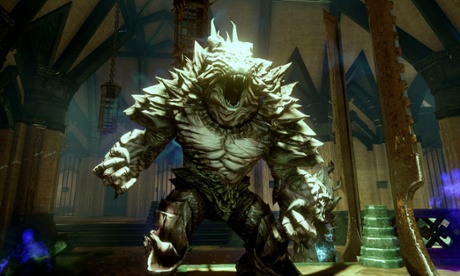
With its vast world, intricate plotting and bustling menagerie of weird, wonderful characters, the latest title in BioWare’s Dragon Age series has proved a critical hit since its release in November.
But how did Inquisition come about? What were the key aims of the team, and how such a massive role-playing adventure like this planned and executed?
In an exclusive interview, we speak to creative director Mike Laidlaw about the development process behind one of this year’s most ambitious titles.
How long was Dragon Age: Inquisition in development?
Production has been about three years, but taking in early concepting, it would be four years. As our studio general manager Aaryn Flynn kindly pointed out, that’s about 10% of my life.
How do you feel now it’s out?
There’s definitely a bit of exhaustion because when you’re finishing a game you go into overdrive: you’re finding those last bugs, playing the game over and over, and prioritising what gets fixed first.
But there’s also a sense of pride. We’ve hauled the game into an entirely new engine and one that is compatible with this generation of hardware. The engine is much more capable than Eclipse, but it required us to retool all of the content we’d been building up and give it a next-gen approach.
It was a monumental challenge supporting five platforms, but the team is proud of what we’ve accomplished and I’m incredibly proud of the team. This was not an easy road, but it has proved very satisfying.
With its open-world structure and redeveloped combat system, how much is the game a response to the criticisms levelled at Dragon Age II?
When Dragon Age II shipped, we did what was always do: internal post-mortems and looking at all the reviews. The production team have a massive Excel sheet listing the pros and cons, and we look for trends. You rarely go: “This one person didn’t like this thing, we should change everything!” That would be irresponsible. But you realise you used that cave a bunch of times and it was inappropriate. Fair call.
You also sit down as a team and decide where your focus should be. We know the party is critical, we’re seeing that backed up by reviews, so let’s bring back full armour customisation but still keep some degree of individualism for the party members; finding that balance is important. Tackle feedback but don’t let it dictate what you should do, let it dictate what you should discuss.
How tricky is it to develop a game simultaneously for PC and a bunch of consoles at the same time?
From the very beginning we were aware we’d be targeting from the 360 and PS3 all the way up to the highest modern PC.
When you know that up front it’s a challenge, but a challenge with clearly defined boundaries. If the older hardware says you can’t have 100 guys on screen, you don’t design your combat fundamentally around it being 100 guy fights. Whatever the limitations are on memory or processor, you lock them down and ask how we make an incredibly cool experience within those constraints.
All design is at its best when there are constraints applied, be it manpower, time, or specific hardware. These things inspire a degree of creativity.
The game’s opening drops you into a high pressure situation with a lot going on: returning factions, characters, and a whole world of established lore, together with a big hole in the sky. How do you strike a balance between making the game accessible for newcomers and still making it satisfying for fans?
Openings are a very specific kind of gameplay. They have to hook you, teach you how to play and welcome you. So rather than take a stately pace that would introduce the world to newcomers – which would be alienating to folks who were returning – we went with a problem that has to be solved, which is priority one for the level and everybody you talk to. It’s all leading to that breach in the sky.
Then we open up the game up as quickly as possible and say it’s all on you player. If you want to engage with the lore then talk to Leliana and ask her if she used to know the warden from the first game; she’ll check if she did from Dragon Age Keep and respond accordingly. This lets you dig into things at your own pace instead of people firing it at you. Players who want to keep fighting demons or see the world can do so, before coming back and exploring the lore later.
Our opening can be disorientating and targeted in its purpose, but you understand the immediate danger and once you’ve completed it the game becomes a sandbox.
Isn’t it frustrating though that you have so many lines of dialogue that will never be heard by 90% of the people playing?
In today’s world you have to look at the game as an ecosystem. That many people not playing still means tens of thousands are hearing those lines. Not bad. Also, for the water cooler experience of “I didn’t understand what was going on with the mages”, you need to make sure the game at least has that information there, so their friend can say “well I get it because I go through every line of dialogue and I can give you the summary”. Players who want to go digging, read the codex, talk to mages and get their take on things; it’s all there if they want it.
I look at games as an increasingly social experience where it’s okay if people don’t understand 100% of what’s going on. There’s a joy in sharing that experience with your friends and social circles.
Part two to follow next week.

